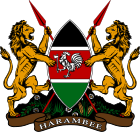| Constitution of Kenya, 2010 | |
|---|---|
 | |
| Overview | |
| Jurisdiction | Kenya |
| Ratified | 4 August 2010 |
| Date effective | 27 August 2010 |
| System | Unitary presidential republic |
| Government structure | |
| Branches | Three |
| Chambers | Bicameral (Parliament) |
| Executive | President |
| Judiciary | Supreme Court |
| History | |
| Amendments | 13 |
| Last amended | 4 July 2019 |
| Author(s) | Committee of Experts |
| Supersedes | Constitution of Kenya Act, 1969 |
| Full text | |
 |
|---|
|
|
The Constitution of Kenya is the supreme law of the Republic of Kenya. There have been three significant versions of the constitution, with the most recent redraft being enabled in 2010. The constitution was presented to the Attorney General of Kenya on 7 April 2010, officially published on 6 May 2010, and was subjected to a referendum on 4 August 2010.[1][2] The new Constitution was approved by 67% of Kenyan voters.[3] The constitution was promulgated on 27 August 2010.[4]
Constitutional reforms involving wholly new texts since gaining independence: in 1969 and in 2010. In 1969, the 1963 independence constitution was replaced with a new text that entrenched amendments already made to the system of government that the independence constitution had contemplated.[5]
These changes included: changing the structure of the state from a federal, or Majimbo system, to a unitary system; creating a unicameral instead of bicameral legislature; changing from a parliamentary to a presidential system with a powerful presidency; and reducing the protections of the bill of rights. Further amendments to the 1969 constitution were later effected, including, in 1982, the institution of a de jure single party government.[5]
The demand for a new constitution to replace the 1969 text with a more democratic system began in the early 1990s, with the end of the Cold War and democratic changes taking place elsewhere in Africa. The single party system was ended in 1991, and the first presidential election took place in 1992. Calls for a comprehensive review of the 1969 Constitution intensified in the late 1990s and early 2000s, helped by the victory of the opposition National Rainbow Coalition (NARC) party in the 2002 general elections. Official and civil society consultation processes led to the adoption of what became known as the "Bomas draft" constitution (after the location of the conference that adopted it).[5]
However, substantial amendments were nonetheless made to this draft prior to a referendum in 2005, resulting in a split in the then ruling coalition. The Liberal Democratic Party faction of the government, led by Raila Odinga, and supported by KANU led a successful 'No' vote against the amended Bomas Draft (called the Wako draft after the alleged mastermind of the changes). The review of the Constitution stalled and negotiations over the adoption of a new text seemed deadlocked. A deadlock only finally broken by the intervention of the African Union through a mediation team headed by Kofi Annan, following the outbreak of serious post-election violence in early 2008.
- ^ Kramon, Eric; Posner, Daniel N. (2011). "Kenya's New Constitution". Journal of Democracy. 22 (2): 89–103. doi:10.1353/jod.2011.0026. hdl:1721.1/71835. ISSN 1086-3214. S2CID 143437814.
- ^ "Kenya referendum date set", Daily Nation, 14 May 2010
- ^ "New Kenyan Constitution Ratified". Voice of America. 6 August 2010. Archived from the original on 27 August 2010. Retrieved 6 August 2010.
- ^ "Institutional Reform in the New Constitution of Kenya", International Center for Transitional Justice (ICTJ)
- ^ a b c See Preston Chitere, Ludeki Chweya, Japhet Masya, Arne Tostensen and Kamotho Waiganjo,"Kenya Constitutional Documents: A Comparative Analysis" Chr. Michelsen Institute, 2006, for a chronology of constitutional negotiations.